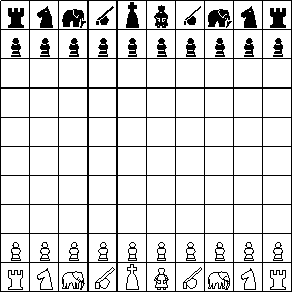Shatranj Kamil
This is an about 1000 years old variant of the game of Shatranj. According to Gollon, who describes this game based on a description of Murray, it was inspired by another similar variant.
The name means Perfect Chess, or Complete Chess.
Rules
The game is played on a 10 by 10 board. In addition to the pieces used in Shatranj, there are two war machines (dabbabah) and two extra pawns per player.
 Setup
1
Setup
1
White:
King e1; General f1; Rook a1, j1; Knight b1, i1; Elephant c1, h1; War machine
d1, g1; Pawn a2, b2, c2, d2, e2, f2, g2, h2, i2, j2.
Black:
King e10; General f10; Rook a10, l10; Knight b10, k10; Elephant c10, h10;
War machine d10, g10; Pawn a9, b9, c9, d9, e9, f9, g9, h9, i9, j9.
Most pieces move like in Shatranj: kings, rooks, and knights as in orthodox chess (but no castling); Generals one square diagonally; Elephants two squares diagonally with the possibility to jump over the first square diagonally; pawns like usual pawns but without the possibility of a double first step. Pawns promote to generals when reaching the tenth row, but only when the player has no general on the board at the moment of promotion - otherwise the pawn reaching the last row is just removed from the board.
War machines (or dabbabahs) move like kings (one square in an arbitrary direction) but are not affected by check.
A player wins the game when he mates the opponent, when he stalemates the opponent. (There is no win by `bare king' in this variant.)
Written by Hans Bodlaender.
WWW page created: July 7, 1997.
